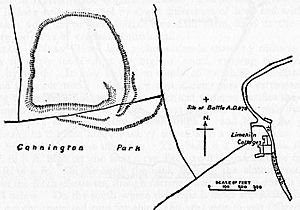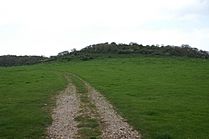Battle of Cynwit facts for kids
Quick facts for kids Battle of Cynwit |
|||||||
|---|---|---|---|---|---|---|---|
| Part of the Viking invasions of England | |||||||
 Cannington hill fort, a possible site of the battle |
|||||||
|
|||||||
| Belligerents | |||||||
| West Saxons | Vikings | ||||||
| Commanders and leaders | |||||||
| Odda, Ealdorman of Devon | Ubba † | ||||||
| Strength | |||||||
| Unknown | 1,200 | ||||||
| Casualties and losses | |||||||
| Unknown | 800 | ||||||
The Battle of Cynwit or Countisbury Hill was a battle between West Saxons and Vikings in 878. The location of the fortress the battle is named for is not known with certainty but probably was at Countisbury Hill or Wind Hill, near Countisbury, Devon. A possible alternative site for the siege and battle is Cannington Camp in the Parrett estuary near Combwich.
Contents
Prelude
The Viking army was said to have been led by Ubba, brother of Ivar the Boneless and Halfdan Ragnarsson, and sailed from Dyfed (where they had overwintered) to land on the coast at Countisbury with 23 ships and 1200 men. On landing, the Viking army discovered that the West Saxons had taken refuge in a stronghold at "Cynuit", possibly Countisbury. According to the 10th century chronicler Æthelweard, the West Saxons were led by Odda, the ealdorman of Devon. The Vikings perceived that the stronghold was unprepared for battle and decided to besiege it, as it did not seem to have any food or water supply.
Battle
According to Alfred's biographer Asser, the West Saxons burst out of the fortress one day at dawn and were able to overwhelm the Viking forces, killing their leader and over eight hundred of his men. They also captured the fabled "raven banner". The Anglo-Saxon Chronicle recorded:
And the same winter the brother of Hingwar and of Halfdene came with twenty-three ships to Devonshire in Wessex; and he was there slain, and with him eight hundred and forty men of his army: and there was taken the war-flag which they called the Raven.
Aftermath
At the time of the battle, Alfred the Great of Wessex was on the run from the Vikings in the marshes of Somerset. It was therefore an important victory for the West Saxons won by someone other than Alfred, who was then leading English resistance to the Viking invasions. In addressing the year 878, the Anglo-Saxon Chronicle claimed that "all but Alfred the King" had been subdued by the Vikings' Great Heathen Army:
This year, during midwinter, after twelfth night, the army stole away to Chippenham, and overran the land of the West-Saxons, and sat down there; and many of the people they drove beyond sea, and of the remainder the greater part they subdued and forced to obey them, except king Alfred
The Battle of Cynwit was one of several triumphant stories recorded by Asser and the Chronicle in 878, ultimately culminating in the English victory over the Vikings at the Battle of Edington.
In fiction
The battle appears in The Marsh King, a children's historical novel by C. Walter Hodges, where its location is called "Kynwit". Although this novel is about King Alfred, it gives due credit to Ealdorman Odda for this victory, although the description of the battle may not be very accurate, showing the Vikings as making a landing at night and being defeated immediately on the landing ground.
The battle also features in Bernard Cornwell's novel The Last Kingdom. Cornwell ascribes the victory, as well as the killing of Ubba, to his hero Uhtred, though he is supported by forces commanded by Odda.
The battle is featured in BBC's and Netflix's presentation of The Last Kingdom. Like the novel that the show is based on, the battle culminates with the show's protagonist Uhtred of Bebbanburg slaying the Viking warlord Ubba in a duel, before Odda's reinforcements arrive to continue and ultimately win the battle.




